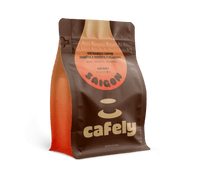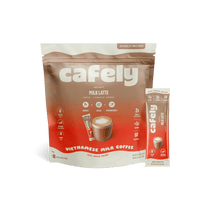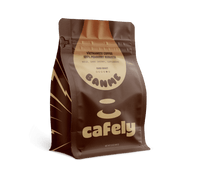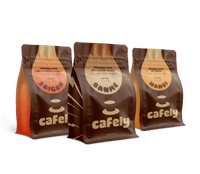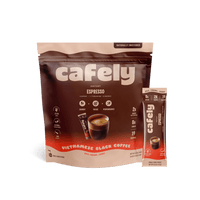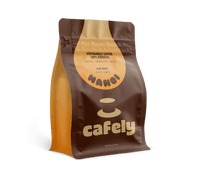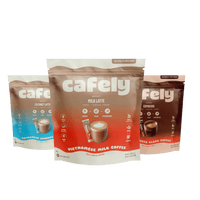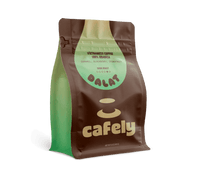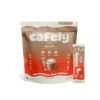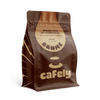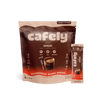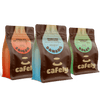Coffee creamer is one of the easiest ways to elevate your morning cup of coffee. Whether you prefer your brew bold and dark or velvety and sweet, adding the right creamer can transform your cup into a smooth, barista-level drink in a flash.
From classic vanilla to seasonal favorites and dairy-free options, creamers offer a simple way to personalize your brew at home.
In this guide, you’ll learn how to use coffee creamer properly to get the richest, most flavorful results. We also have some tips on how to choose the right creamer, the best beans for making creamy coffee, and the best brewing methods…
How to Use Coffee Creamer: Step-by-Step Guide

Using a coffee creamer is easy enough, but you should follow a few steps to create the most flavorful cup.
Here's how to use coffee creamer in five simple steps:
1. Choose Your Coffee Creamer
First, select a creamer that suits your taste and dietary preferences. Store-bought options range from classic dairy creamers to plant-based, sugar-free, and flavored selections.
Homemade coffee creamers allow for full customization of flavor and dietary needs, and you can use fresher ingredients.
2. Brew Your Coffee
Prepare your coffee using your preferred brewing method. Drip coffee, French press, pour-over, cold brewing, and moka pot all work well for making coffee with creamer. You can even elevate a basic cup of instant coffee with a creamer.
For the best results, use high-quality whole-bean coffee and grind it fresh before brewing. Make sure to use fresh, filtered water and the correct coffee-to-water ratio for the brewing method.
3. Add Sugar, Syrup, or a Sweetener (Optional)
If you enjoy sweet, dessert-like brews, add sugar, a sugar-free sweetener, or your chosen flavored syrup to your bold cup of black coffee. Stir to combine.
Adding the sweetener before the creamer allows it to dissolve evenly while the coffee is piping hot.
4. Add the Creamer
Pour your chosen creamer into the coffee slowly. Start with one to two tablespoons and adjust to taste from there. Use more for a creamier, more velvety texture or less to allow the flavors of the coffee to shine through.
5. Mix Well and Enjoy
Stir the liquid thoroughly to blend the coffee and creamer. Give your beverage a quick taste — add more creamer or sweetener if needed.
Once you’re happy, sit back and enjoy your perfectly balanced cup of white coffee.
How to Choose the Right Coffee Creamer

There are two main types of coffee creamer to choose from — homemade and store-bought. However, there are several ways to make coffee creamer and hundreds of different flavored combinations. Finding the right creamer for you can be a challenge — after all, everyone's taste is different.
Here are a few things to consider when choosing a coffee creamer:
Store-Bought Creamer
Store-bought coffee creamers are convenient and widely available in both dairy and non-dairy options.
You’ll find creamers in both liquid and powder forms. Liquid creamers taste fresher and contain fewer additives. Powdered creamers don’t taste as creamy and can contain a range of preservatives. However, they’re convenient and have an extremely long shelf life.
If you value convenience, consistency, and variety (within reason), store-bought creamer is the best option. However, if you have a delicate taste or specific dietary requirements, it may be better to make creamer yourself.
Homemade Creamer
Making coffee creamer at home gives you complete control over what goes into your cup. You can make a simple creamer base of 50% heavy cream or condensed milk and 50% whole milk. From there, you can add a range of syrups, sugars, sweeteners, or spices to suit your taste.
You can also make homemade creamer from a variety of different plant-based milk alternatives. You can make a vegan creamer base by combining oat milk, almond milk, coconut milk, or soy milk with oat cream or coconut cream. You can then flavor and sweeten the creamer with a range of different syrups or sweeteners.
Homemade coffee creamer is the best option for those who enjoy experimenting with ingredients, want to consume fresh ingredients, and desire full control over what goes into their bodies.
Coffee Creamer Flavors
Flavors can completely transform your cup of coffee. Creamers are available in a range of different flavors. You’ll find vanilla, hazelnut, caramel, and a range of seasonal blends available in-store.
When it comes to homemade creamers, the sky's the limit in terms of flavors. You can combine a range of different flavored syrups, extracts, spices, or sweeteners with homemade creamer to enhance its taste.
Here are some popular coffee creamer flavors:
- Vanilla — Smooth, sweet, and classic. Vanilla is one of the most popular flavors for coffee and creamer. It adds a creamy softness with subtle floral and custard-like undertones.
- Caramel — Rich and buttery with toffee-like hints. Caramel adds a dessert-like depth of flavor that pairs well with dark roast arabica in both hot and iced coffee.
- Hazelnut — Nutty and warm with a slightly sweet, roasted flavor. Hazelnut creamer adds a cozy, sweet, earthy flavor that pairs well with a range of beverages, both hot and cold.
- Mocha Creamer — A chocolate-flavored coffee creamer that, when added to strong dark roasts, can create a quick and easy mocha coffee.
- Pumpkin Spice — A seasonal favorite made popular by Starbucks, pumpkin spice creamer combines cinnamon, vanilla, nutmeg, and clove. This creamer delivers a warm, spiced dessert-like sweetness reminiscent of fall-time pies.
- Toffee Nut — Buttery and nutty with hits of burnt sugar and caramelized nuts. Toffee nut creamer adds a rich, indulgent, sweet flavor to any brew.
- Coconut Creamer — Light, creamy, and tropical, coconut coffee creamer adds a refreshing creaminess to coffee. It’s especially good when combined with strong robusta in Vietnamese iced beverages.
- Creme Brulee — Creme brulee creamer is inspired by the French dessert. It adds flavors of custard, vanilla, and caramel. It’s perfect for making brûlée lattes and sweet, indulgent iced coffee.
What Coffee Pairs Well With Creamer?

Coffee creamer pairs well with most medium and dark-roast coffee. However, robusta, arabica, and blends all produce different experiences, flavor notes, and caffeine levels.
Here are three different types of coffee that pair well with coffee creamer and the experiences they offer:
1. 100% Arabica
Arabica coffee is the most popular and widely consumed coffee species in the world, making up around 60% to 70% of global coffee production. It’s prized for its smooth, nuanced flavor, low bitterness, and natural sweetness. Arabica coffee has a mild caffeine content and works well with most brewing methods and creamers.
If you enjoy smooth coffee with a mild acidity and caffeine content, opt for a high-quality arabica coffee. We recommend Cafely DaLat for hot white coffee made with creamer and sweetened iced beverages.
2. 100% Robusta
Robusta coffee is the second most popular coffee species in the world, making up around 30% to 40% of global coffee production. It’s known for its strong, bold, dark flavor and extremely high caffeine content — around twice as strong as arabica.
Robusta is often considered to be the “poor-quality” cousin of arabica because of its intense, dark, bitter flavors. However, when prepared correctly, robusta’s intense flavor and aroma can be delicious.
Due to the strong, bitter flavor of this coffee type, it’s best to sweeten and cream it — this is why Vietnamese coffee is often paired with condensed milk.
100% robusta, such as Cafely HaNoi, is the perfect candidate for combining with sweetened coffee creamer. It works especially well in iced coffee made with vanilla, caramel, or hazelnut coffee creamer.
3. Arabica and Robusta Blends
Blends made from robusta and arabica combine the qualities of both beans. Well-balanced blends such as Saigon OG offer the strong, dark, bold flavors of robusta, mellowed by the sweet, subtle, nutty notes of arabica.
A well-balanced blend is the perfect candidate for a range of different creamy beverages. You can brew it hot using a pour-over or phin-filter and combine it with creamer and sugar for a Vietnamese-inspired white coffee. You can also combine cold brew robusta with ice and vanilla creamer for a delicious dessert-like iced coffee.
If you’re looking for an “all-in-one” coffee to use with coffee creamer in a range of different beverages, blends like Saigon OG and DaNang are great options.
Best Brewing Methods for Making Creamy Coffee
Most immersion brewing methods make good coffee if high-quality beans are used. However, some brewing methods are better for use with creamers.
Here are the four best brewing methods for making white coffee:
1. French Press
The French press is an immersion brewing method that makes bold, full-bodied coffee. It’s a simple brewing method that requires very little in terms of equipment. The natural richness of French press coffee pairs exceptionally well with creamers, creating a smooth and creamy texture without losing depth of flavor.
Here’s how to make coffee with a French press:
What You Need:
- French Press — You'll find French presses in a range of sizes and styles, ranging from 1-cup servings up to 12-cup servings.
- Coffee Grinder — The best brews are made from freshly-ground, whole-bean coffee. Use a burr or blade grinder to achieve the coarse consistency needed for the French press.
- Kettle — Use an electric or stovetop kettle to boil water.
- High-Quality Coffee — Opt for a high-quality 100% arabica or a well-balanced blend such as Saigon OG.
- Water — Use fresh, filtered water to make the brew.
- Creamer — Use your preferred creamer to cream and sweeten your brew.
Step-by-Step Guide:
- Boil a Kettle of Water — Bring a kettle of fresh, filtered water to a boil.
- Grind and Measure the Coffee — Grind around 17 grams (2–3 tbsp) of coffee to a coarse consistency. This is enough to make one serving — multiply the amount if you plan on making multiple servings.
- Add the Coffee and Water — In your French press, add the coffee followed by one cup of water (per serving). Place the lid on, but don't press the plunger down yet.
- Wait for the Coffee to Steep — Leave the grounds to steep for around four minutes. The longer you steep the grounds, the stronger and more bitter the brew will be.
- Plunge and Pour — Once steeped, gently push the plunger down to separate the grounds from the brew. Then, slowly pour a serving into your favorite coffee mug.
- Cream and Serve — Add a dash of your favorite coffee creamer, stir to combine, and enjoy while warm.
2. Pour-Over

Pour-over coffee is another immersion brewing method that creates filter coffee. Hot water is manually poured over ground coffee through a paper filter — the brew is collected in a single cup or pot below. Pour-over coffee tastes great black when made with high-quality coffee, but it tastes even better when combined with a good creamer.
Here’s how to make pour-over coffee:
What You Need:
- Pour-Over Brewer — There are several to choose from. The Hario V60, Chemex filters, user-friendly Clever Drippers, and a compact Kalita Wave all work well.
- Coffee Grinder — The best brews are made from freshly-ground coffee. Use a burr or blade grinder to achieve the medium grind size needed for pour-over.
- Kettle — Use a stovetop or electric kettle to boil water.
- High-Quality Coffee — Opt for high-quality whole-bean coffee. Arabica, robusta, or a blend all work well, which type you choose comes down to preference.
- Water — Use fresh, filtered water for making pour-over coffee.
- Creamer — Use your favorite creamer.
Step-by-Step Guide:
- Boil a Kettle of Water — First, boil a kettle of fresh, filtered water.
- Measure and Grind the Coffee — measure and grind your coffee to a medium to medium-coarse consistency similar to table salt. The amount and exact grind size you need will vary depending on the pour-over setup you own.
- Prepare the Filter — Place a paper coffee filter in your pour-over device. Pour half a cup of hot water over the filter and discard once it passes through the filter. This has two benefits — it washes any impurities from the filter and preheats your equipment.
- Bloom the Coffee — Place your coffee grounds in your pour-over, making sure they're spread evenly across the filter. Then, pour in just enough hot water to cover the grounds and wait for 30 to 60 seconds for the gases to escape. This is known as the bloom stage — it makes for a more even extraction.
- Brew the Coffee — Once your coffee has bloomed, pour over the rest of your water slowly. Wait for the brew to drip through to the container below; this can take anywhere from two to 10 minutes, depending on the brewer.
- Pour the Brew — Once all the water has passed through the filter, remove the pour-over and slowly pour the brew into your favorite coffee mug.
- Add Creamer and Serve — Add a few tablespoons of your favorite creamer, stir, serve, and enjoy.
3. Drip Coffee
Drip coffee is similar to pour-over, but it's made using an automatic coffee machine. You don't have as much control over flow rate and extraction with a drip coffee maker. However, it's a consistent brewing method — each pot of coffee tastes as good as the last.
The dark, bold flavors and clean body of drip coffee work well with creamer. The simplicity of the brewing method also makes it the perfect candidate for daily, morning brews.
Here’s how to make coffee with a drip coffee maker:
What You Need:
- Drip Coffee Maker — These machines come in a range of shapes and sizes, but they all work in more or less the same way.
- Coffee Grinder — The best drip coffee is made with freshly-ground whole-bean coffee. Use a burr or blade grinder to achieve the medium grind needed for drip coffee.
- High-Quality Coffee — Opt for a high-quality arabica or arabica-rich blend.
- Water — Use fresh, filtered water in your drip coffee maker. This makes for a cleaner cup and prevents mineral buildup in your machine.
- Creamer — Use your favorite creamer.
Step-by-Step Guide:
- Prepare Your Drip Coffee Maker — Fill the reservoir of your machine with cold, fresh, filtered water. Take a coffee filter, rinse it with filtered water, and place it in the hopper.
- Grind the Coffee — Grind around 14 grams (2 tbsp) of coffee per serving. Aim for a medium consistency similar to sea salt.
- Brew the Coffee — Place the ground coffee in the filter, close the lid, and place your carafe on the drip tray. Turn on the machine and wait for the coffee to brew.
- Pour and Cream — Once the coffee has brewed, pour a serving into a coffee mug. Add creamer to taste, and enjoy.
4. Cold Brewing
Cold brew is made by submerging ground coffee in cold water for a long period — usually 18 to 24 hours. This gentle method of extraction results in a low-acidity coffee with subtle, floral notes and a surprisingly strong caffeine content.
Although cold brew is often consumed black, you can make a delicious iced coffee by adding sweetened creamer.
Here’s how to make cold brew coffee:
What You Need:
- French Press — Use a large French press to make multiple servings of cold brew.
- Coffee Grinder — The best cold brew is made from whole-bean coffee. Use a burr or blade grind to achieve the coarse consistency required for this brewing method.
- High-Quality Coffee — Opt for a high-quality, whole-bean arabica such as DaLat.
- Cold Water — Use cold, fresh, filtered water.
- Creamer — Use your favorite creamer to make a creamy iced cold brew. We recommend vanilla creamer.
- Ice (optional) — Cold brew is best served over ice.
Step-by-Step Guide:
- Grind the Coffee — Grind 14 grams (2 tbsp) of high-quality coffee per serving. Aim for a coarse consistency similar to unprocessed kosher salt.
- Combine the Ingredients — Add the ground coffee to your French press and pour in one cup of cold, fresh, filtered water per serving of coffee. Stir until the grounds are thoroughly saturated.
- Steep the Coffee — Place your French press in the refrigerator and leave it to steep for 18 to 24 hours.
- Strain and Store — After 18 to 24 hours, remove the French press from the fridge and push the plunger down gently to strain. If you have made multiple servings, pour the brew into a separate airtight container and store in the fridge — this prevents over-brewing.
- Assemble the Iced Coffee — In a large glass, add ice. Then, pour over your cold brew and add creamer to taste. Stir to combine and enjoy while ice cold.
FAQs: How to Use Coffee Creamer
Do you have more questions about coffee creamer you'd like answered?
Check out the answers to the frequently asked questions below, you may find what you're looking for…
1. What is Coffee Creamer?
Coffee creamer is a dairy-based (or non-dairy-based) product used to add creaminess and flavor to brewed coffee. It's available in both liquid and powder forms and (usually) consists of a 50:50 mix of milk and cream. Creamers are often sweetened with sugar, syrup, or sugar-free sweeteners and may contain additional flavors such as vanilla, caramel, or hazelnut.
2. How is Coffee Creamer Made?
Coffee creamer is usually made by combining pasteurised milk and cream. Store-bought liquid creamers may also be combined with preservatives, flavorings, sweeteners, and coloring. Powdered creamers are typically made by combining a range of powdered dairy products, sweeteners, and stabilisers.
3. Can You Make Coffee Creamer at Home?
Yes. You can make coffee creamer at home, and it may be a better option over store-bought products. You can make coffee creamer by heating milk, cream, and your choice of sweeteners and flavorings before cooling and storing. Homemade creamer is generally cheaper than pre-made options and may be healthier due to the lack of preservatives and the control over sugar content.
4. What's the Best Coffee Creamer?
The best coffee creamer for you comes down to personal preference. Dairy-based creamers, vegan plant-based creamers, and several different flavored options are available. Which type is “best” for you depends on your taste, dietary requirements, and the type of coffee you use it with.
5. What's the Best Coffee for Coffee Creamers?
Medium to dark roast coffee pairs well with most creamers. Their caramelized, nutty flavors complement the creamy, sweet notes of most creamers. The floral, “green” flavors of lighter roasts tend to clash with these notes. Medium to dark roast robusta, arabica, and blends can all work well — the best option comes down to personal taste.
6. How Should You Brew Coffee for a Creamer?
You should brew strong to medium-strength coffee to ensure its flavors shine through the creamer. Brewing methods such as French press, pour-over, and drip brewing are popular when making white coffee.
7. How Long Does Coffee Creamer Last?
Store-bought liquid coffee creamers typically last for one to two weeks after opening if stored in a refrigerator. Powdered creamer has a much longer shelf life — several years if it’s stored in an airtight container. Homemade coffee creamer has a shelf life of three to seven days, depending on how it's made and stored.
8. How Much Sugar is in Coffee Creamer?
The amount of sugar in coffee creamer varies widely depending on brand and type. Flavored creamers can contain anywhere from three to 10 grams of sugar per tablespoon, whereas unflavored, unsweetened creamers can contain less than one gram.
Look for sugar-free or low-sugar options if you're concerned about your intake.
9. How Much Creamer Should I Use Per Cup of Coffee?
This comes down to taste. However, three to four tablespoons is enough for most people. If you're new to coffee creamer, start with one to two and add more to adjust to your taste.
10. What Coffee Creamer Does McDonald's Use?
McDonald’s iced coffee typically uses a proprietary blend of cream and milk in its white coffee. However, the exact formulation used varies by beverage type and region.
